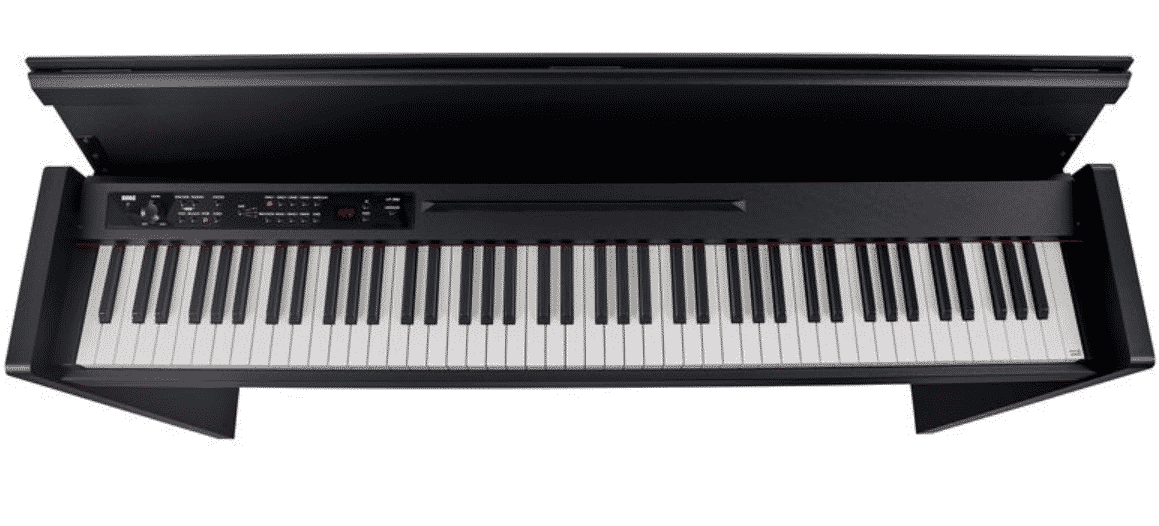
In this review, we’re going to take a thorough, in-depth look at the Korg LP380. This piano is an intermediate level slimline digital piano, priced in the middle of the market. However, it’s far from an average piano, and you get a lot for your money.
The Korg LP380 is an upgrade from the LP350 and includes a multitude of new features. Korg may not be a household name just yet in digital pianos. They are a Japanese company that specialise mainly in synthesisers and electronic music equipment. However, they have quite an extensive and high quality digital piano range.
The LP380 is a fantastic choice for anyone who requires the feature set of a full size digital piano, but doesn’t have a whole lot of space. This model isn’t designed to be portable, and certainly isn’t as portable as the Korg B1, but it can be moved around fairly easily if necessary.
I spent around six or seven hours trialling and researching this model. So, should you buy a Korg LP380? Is it worth your money?
Korg LP380 Summary
Features
An acceptable, but not mind blowing feature set. Some significant features missing, such as the ability to record your own pieces.
Sound
A high quality piano tone that's not too mellow or too bright. A great, powerful speaker system that isn't prone to distortion.
Price
Good value for money if you're on a budget, and a serious contender to the Yamaha and Roland alternatives. However, quite dated.
Pros
Cons
Korg LP380 Summary after six hours of testing:
A great intermediate level piano, perfect for someone looking for their first “real” piano after having practiced on a keyboard or a cheaper digital piano and looking to upgrade. If you’re in an apartment or small home and space is at a premium, the slimline design ensures you don’t have to sacrifice space.
Build quality is maybe a little questionable but I wasn’t able to keep this model long enough to test this in full.
For home use, this piano is a great choice. You’ll save yourself money over equivalent models from the big players in this market (Yamaha and Roland) but in reality, I’d say the Korg comes pretty close in terms of quality and features. However, the Korg LP380 is a practice piano, if you need portability, or you need to perform on your piano, this isn’t the instrument for you.
Our Rating: 4/5
Check the availability and the current price of the Korg LP380
Now, let’s get started on a review of the Korg LP380. Let’s first have a look at the specification list.
Full Specification List
For a complete specification list, please visit korg.com.
Design
I really like the job Korg has done on designing the Korg LP380. I think that while it looks a little basic, the design is very functional, and will fit into almost any modern home.
The LP380 has been designed to be as thin as possible without compromising on quality and player experience. I’m pleased to say Korg have managed to fit an excellent piano into a very thin and lightweight casing. It comes in at only 26cm in depth, and as a result will fit almost anywhere.
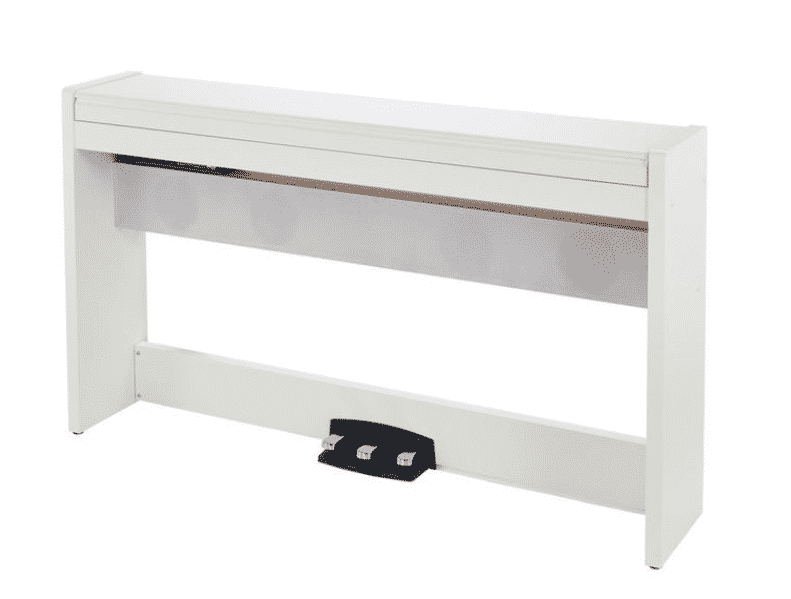
Another excellent feature is the soft-close lid, which doubles as a music stand. This is a feature of most slimline digital pianos, and while it’s an excellent piece of design, it does mean you can’t rest a laptop on of the piano in the same way as you can with a console digital piano, so the LP380 may not be the best choice for composing.
One thing I will say is that styling of the Korg LP380 isn’t really going to win any awards. Yes, it’s functional, but it doesn’t look as good as a Yamaha YDPS52, and comes across as utilitarian and basic. You may not care for this (I don’t, particularly) but it’s worth considering if aesthetics are a primary concern in your home.
Weight
The Korg LP380 weighs in at 37kg including the stand, which is 5kg lighter than its’ predecessor, the LP350. This again is great news for anyone who might need to move their piano around on a regular basis. 37kg certainly is not light, but this piano isn’t designed for portability, so you probably won’t be taking it to gigs and concerts on a regular basis.
I get concerned when I review pianos that feel too light; it makes me feel like they manufacturer has scrimped on the quality of materials and the piano isn’t going to last very long. Sometimes a piano being too light can cause issues when playing too; the keyboard tends to move and bounce around. I didn’t have this problem with the LP380.

One important thing to note about the LP380 is that it’s exceptionally energy efficient. It only consumes around 15W of power when in use; other models can consume around 40 -60W of power. If you’re looking to keep your energy bills as low as possible, the Korg LP380 is a great choice.
Assembly
Seeing as the Korg LP380 comes with a stand and pedal box, it will require some assembly. Fortunately this isn’t too difficult, and there are good instructions in the box as to how to do this.
One thing I will say about the assembly of the piano is that the materials used do feel a little cheap. While the keyboard itself is nice and weighty, the stand and supporting materials feel very thin.
I’m sure this is as a consequence of the piano being so light, and I have to say when the piano was put together and I was playing it I didn’t really notice this. However, it’s something to consider; when I’ve assembled similar models from Roland and Yamaha, the materials felt of better quality.
The assembly is fairly straightforward; lay the keyboard flat, attach the two sides with the included screws, and then attach and plug in the pedal board. Easy!
If you’re struggling to put the piano together, there is a really useful video from Korg on how to assemble it. It is in Japanese, but visually you should be able to follow along using the instructions as reference.
Controls and Buttons
One thing I really like about the Korg LP380 is its control system. So many times I’ve written about pianos in this range that use this stupid function + key press model. It results in you either having to keep the manual next to the piano at all times in case you want to change a voice, or memorising all the function and key combinations. Silly.
I’m pleased to say that Korg have made operating the LP380 very easy; you simply have buttons for everything. To change to the piano voice, for example, you press the “piano” button, then the “bank” button to choose which piano sound you require. And get this; there’s an LED screen that gives you the number of the voice you’ve selected!
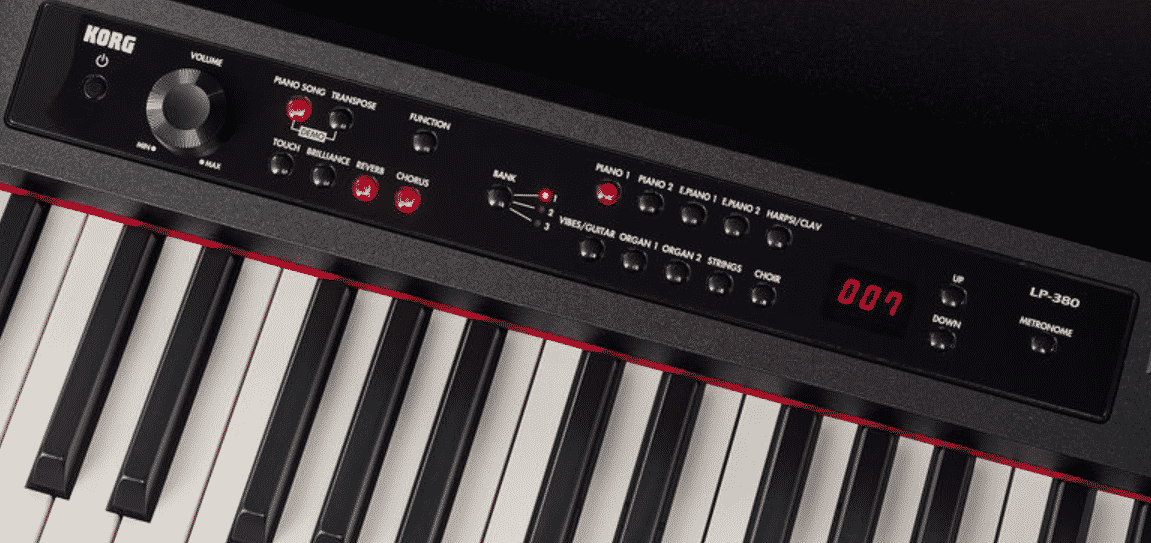
You may spot the sarcasm here but I’ve been banging on about this for years with the likes of Yamaha and Casio not bothering to include a simple screen, and basically just leaving us to either memorise the combinations or guess. Korg’s control system is a victory for common sense, and in all honesty for me this is one of the reasons I’d choose this model over the equivalent Yamaha or Casio model.
Because of this I have no criticisms of the control model on the Korg LP380 at all. It just works, and you don’t need to consult the manual for it. Of course, this means you have lots of buttons on your piano, and if you like the minimalistic look, this might put you off. In all honesty I didn’t find it distracting, and felt it was a real welcome change after trying so many pianos with a clunkier way of doing things.
Of course, for some of the more advanced functions, you might find that you need to look at the manual every now and then. However, for the typical functions you’ll need in day to day playing, such as changing voices, adjusting volume or transposition or using the metronome, you’ll find the Korg LP380 very, very easy to use.
Pedals
Like many other models of digital piano, the Korg LP380 comes with an included pedal board. The design is slightly strange, as the pedal board is literally just a board of MDF with a pedal box added to it. It looks a little weird in my opinion; just as though the pedals were an afterthought, and the Roland F140R for example looks so much better as the pedals have been better included in the overall aesthetic.
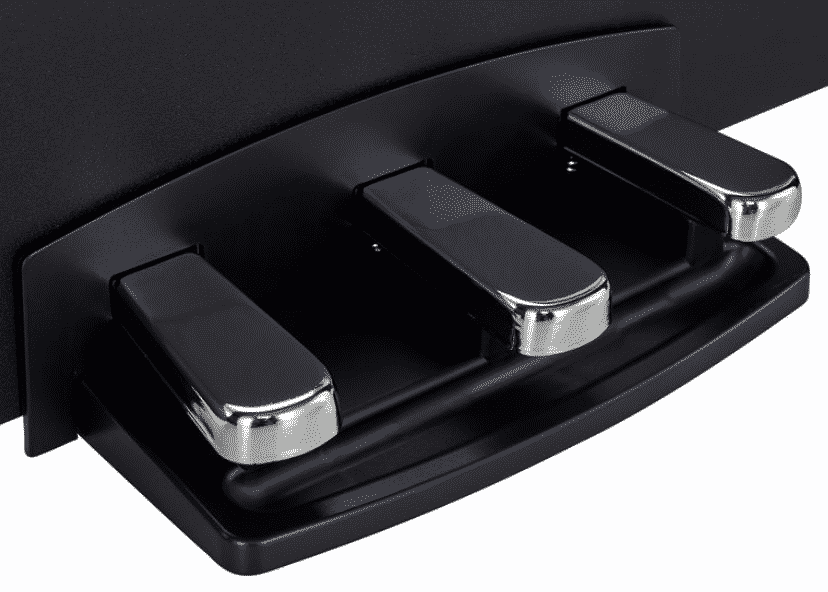
However, to use, the pedals are good. Nothing to write home about, but they are perfectly adequate for the job at hand. If you’re more advanced, you may find that you don’t get so much control over the pedals as you would with a real piano, as the LP380 only supports half-pedalling and full pedalling. Although, to be honest, if you’re worried about this I’d imagine you’ll be looking in a higher price range anyway.
The pedals did feel a little spongy. I can’t really decide how I feel about this; if you play a Steinway grand piano you’ll find the pedals very heavy and not like Korg’s at all. but a Yamaha upright’s pedals are much, much lighter and are closer to what Korg have developed. I think I’d prefer a slightly heavier set of pedals, but there’s nothing wrong with the LP380’s pedal set. The inclusion of three pedals will certainly help towards your musical development and overall control of the instrument.
Colours
The LP380 comes in a variety of colours. The one I tested was black, and this seems to be the most popular model, but you can also get the piano in white. There are models in red, rosewood grain, black and red and rosewood/black finish. I wasn’t able find many of these models for sale in the UK, where I’m based, however; mostly I could only find the black and white examples.
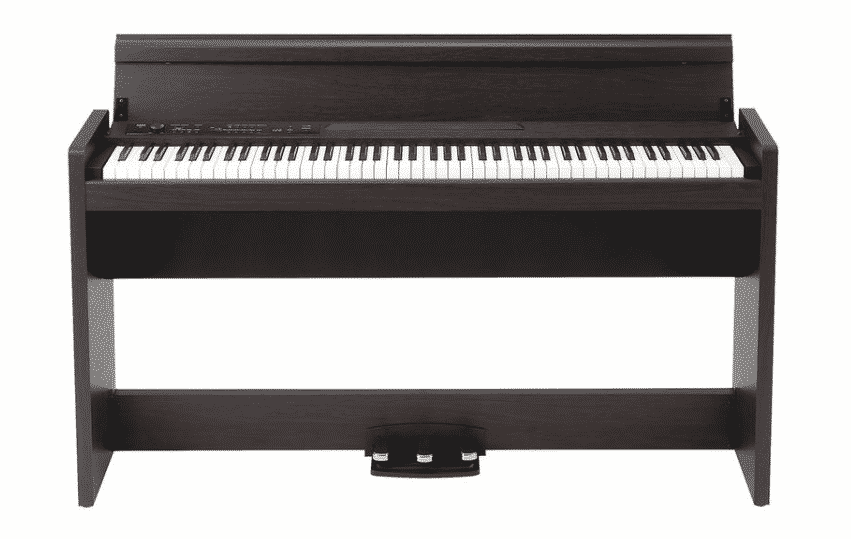
The Rosewood Finish model.
If you’re dead set on any of the other colours, you may have to look a little harder than usual for them. However, I think they look pretty good, so pick the one that best blends in with the aesthetic of your home.
Piano Sound
Let’s talk about the piano sound of the Korg LP380; one of the most important factors when choosing to buy a digital piano.
The LP380 uses Korg’s Stereo Piano System. I wasn’t able to find much information about this system, and Korg don’t really shout about it in the way that other manufacturers do about their sound system. However, I found the LP380’s piano sounds of high quality, with a rich tone and most importantly, the sounds aren’t too bright.
The LP380 includes five piano sounds; two classic grand piano sounds, a jazz piano sound, a honky-tonk piano sound and a more modern, live, pop-style grand. I have to say I was only really interested in the classic grand piano sound, and possibly the honky-tonk sound. Here's a full list of the piano sounds included.
The classic and grand piano sounds on the LP380 are great, but perhaps a little behind the curve when it comes to other manufacturers, as it doesn’t include advanced features such as damper and sympathetic resonance, etc.
Have a listen to the grand piano sound and see what you think. I’d put it above Casio, but below Yamaha and Roland in terms of authenticity.
Other Included Sounds
The LP380 features 30 included voices in total; 25 extra sounds not including the piano sounds we've already discussed. They are:
In my opinion this is a little overkill on the supplementary sounds such as strings and choir; I’d have preferred Korg put their time into developing a more refined piano sound. However, the sounds are all very high quality; comparable with other instruments in this price range.
Speakers
Korg have included a set of 22 Watt, 10cm amplifiers in the LP380. I have to say, I felt the speakers were of very high quality. It seems Korg has put more time into the speaker system on this piano than anything else, and it shows. The speakers are certainly a lot more robust than the speakers you get on other models in this price range, which allows for a lot more expression in your playing.
It’s very pleasurable to play the piano with the included speakers, and due to the extra power you get, it’s no issue to turn it up right to maximum volume; I noticed no distortion or crackling. I expected a decent set of speakers for this kind of money, and I’m pleased to say Korg have overdelivered here.
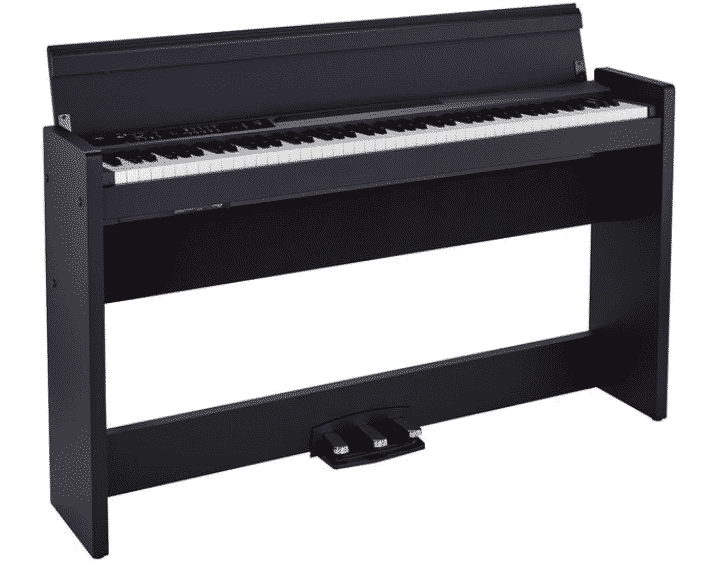
Korg have also included two headphone jacks on the LP380; pretty standard across the industry but a welcome feature nonetheless. This means that you can not only practice in complete silence if you so wish, but you can also play duets and have lessons just wearing headphones as well.
Effects and Reverb
Playing into Korg’s synthesiser roots, there’s actually quite a few different sound effects available on the LP380. You get three options; reverb, chorus and brilliance.
Reverb gives the impression you’re in a different acoustic, and changes the selected sound to suit that particular acoustic. So, for example, you can change between a very dry acoustic, like a small room, to a wetter acoustic such as a concert hall or stadium.
The Chorus effect layers the sound so that it seems as though multiple instruments are playing at once. The brilliance effect adjusts the tone of the selected sound, so you can make it brighter or mellower depending on your mood or the music you’re playing.
I appreciated the brilliance effect, as this allowed me to tone down the brightness on some of the piano sounds. This isn’t something you get with most other manufacturers, and is definitely welcome.
Additional Sound Features
The other features on the Korg LP380 are pretty standard. You get a line out, so you can plug it into a speaker system. This is good news for gigging musicians, so if you take your piano to somewhere with a PA system, you can plug it right in without having to worry about bringing your own speakers.
You also get MIDI in and MIDI out. This is great if you want to connect to legacy equipment, but most pianos today feature USB to Host which is arguably much better, not in terms of functionality but in terms of usability. USB to Host makes it far easier to plug into a laptop or computer. With the LP380, if you want to plug into a computer you’ll need either a dedicated sound card with MIDI sockets or a USB-MIDI adapter.
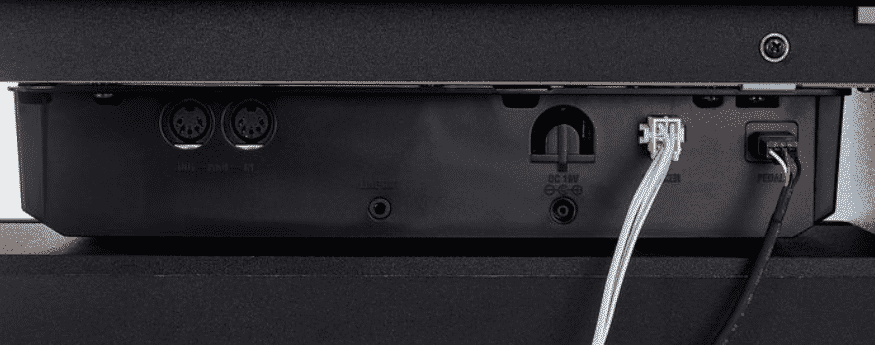
The other sockets are as you’d expect; power, pedals and headphones.
Modes
I felt the Korg LP380 a little lacking in terms of the modes you get. While other models from other manufacturers include useful little tools and features such as bass split, the Korg only features two modes; layer mode and partner mode.
Layer Mode
Layer mode does exactly what it says on the tin; it allows you to layer two sounds and play them both at the same time. This allows you to combine piano and strings, for example, or electric organ and piano.
Partner Mode
Partner mode is a useful feature that basically splits your 88 key keyboard into two 44 key keyboards. It allows you to play in the same range with another person, with the keyboard divided in half between you and them.
If you’re a teacher, this is great news, as it allows you to demonstrate something, and then the student can replicate it on the same piano, without the teacher having to move out of the way.
Functions

Polyphony
The Korg LP380 features 120 note polyphony. This is a strange number, as most pianos have either 96 note polyphony or 128 note polyphony. 128 notes is less than I was expecting, and even though this should be sufficient for most players, it’s quite easy to see how you’d run out of notes if you have multiple effects, chorus, reverb and sustain pedal at the same time.
If you want to learn more about polyphony and why it’s important, check out this article on what polyphony is.
I would unfortunately consider this a dealbreaker. While I was playing the piano, specifically a piece of Debussy which involved dense harmony and lots of pedalling, I found myself running out of notes and I could audibly hear some of the notes drop out. This isn’t great, and unfortunately if you’re any kind of advanced player, you might find yourself hitting the limit of polyphony on the LP380.

Transposition
As with most other digital pianos, the LP380 has a transposition feature. You can transpose up to six semitones down and five semitones up, which is fairly standard. What I like about the transposition function on the LP380 is how it’s controlled; you simply press the transpose button, and then press the key on the keyboard relative to the number of semitones you want to transpose by.
As far as I could work out the LP380 doesn’t feature an octave shift mode, which for me wasn’t a huge issue, but if you use this feature a lot on your current piano, it might be a reason to look elsewhere for a new one.

Fine-Tuning
The LP380 allows you to alter the pitch of your music in smaller increments than the transpose function. This is done in increments of 0.5Hz, and is designed to allow you to match another instrument’s tuning exactly, if they are slightly sharp or flat.
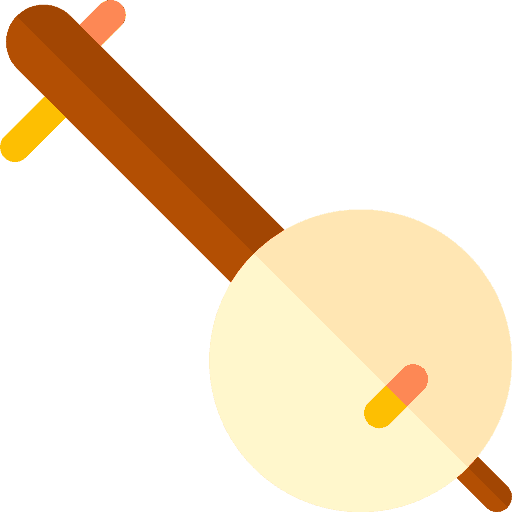
Temperament
The Korg LP380 includes a rare feature that allows you to alter the temperament of the music you’re playing. Without giving you a history lesson, temperament refers to the intervals between notes, and how they are tuned. Most pianos today use what’s called “equal temperament,” but historically instruments have been tuned slightly differently to allow for a slightly different sound.
This is really helpful if you’re into historically informed performance, and allows you to select numerous historical temperaments including Werckmeister temperament and pure temperament. It also allows you to experiment with different types of music, and allows you to play in Arabic temperament, Slendro and Pelong temperaments for Indonesian music and more. There are 9 temperaments included with the Korg LP380.
This is a great feature, and while I might not use it very often, it’s exceptionally useful and should be included across more pianos and more manufacturers.
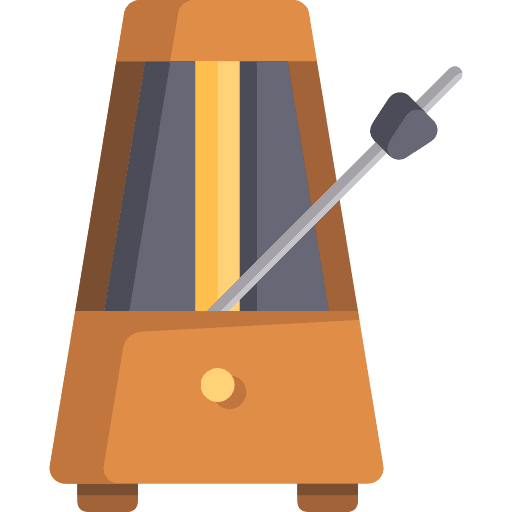
Metronome
As is standard in the industry, the LP380 includes a metronome. This is a useful practice tool and one that I think everyone should use. You can change between time signatures, allow for an accent on a particular beat, adjust the volume; this is one of the most feature-packed metronomes I’ve seen in a digital piano, and it’s great. Top marks to Korg here.

Recording
Amazingly, I could find no way of recording a piece on the Korg LP380 and playing it back. I’d really love to be proved wrong here, because this is such a standard feature, but it’s not mentioned in the manual and I couldn’t find a “record” button on the casing. This is a real disappointment; I would expect at least two track recording on any digital piano nowadays, and it’s almost universally included on pianos even in the very lowest price range.
Of course, you could connect the line out to a recording device, or use MIDI functionality to record, but that’s not the point; sometimes you just want to hear your playing back quickly and without bells and whistles. I was very disappointed in this.
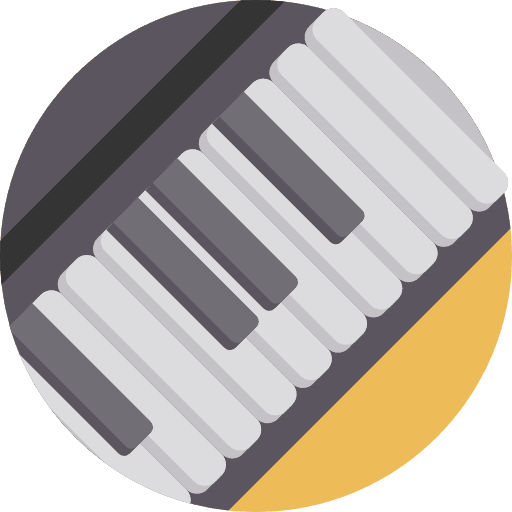
Built in music
There are 30 built in demo songs available on this piano, including some well known pieces. However, I couldn’t find a way to load my own music into the piano via MIDI, and there’s no lesson function or split function. I don’t mind this so much; this is mainly a feature included on lower end, beginner digital pianos. However, if this is important to you, you may want to consider a different instrument.Keyboard
This is by far the most important thing to any pianist aside from the piano sounds. Let’s take a good look at the keys and the action. Do they live up to expectations?
The Action
Korg has included their RH3 (Real Weighted Hammer Action 3) keyboard in the LP380. This is just a fancy name to describe the fact that Korg have tried their best to replicate the feel of a real piano with real hammers.
As you’d expect (and as the name points out) the action is weighted, and it’s also scaled, meaning it’s heavier in the bass and lighter in the treble, as with a real piano.
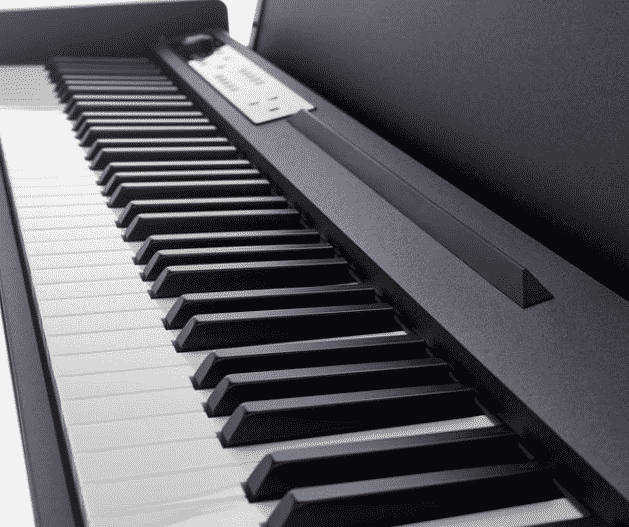
The RH3 action, in my opinion, leaves much to be desired. It’s an OK action, and it replicates the feel of an acoustic piano quite nicely. However, I found the action to be incredibly heavy for a digital piano. If you’re used to playing an upright piano, it’s very rare you’ll find an action as heavy as you will on the LP380. A grand piano is a different story, but then the other limitations of the RH3 action come into play.
Korg's action has omitted so many features you get on other brands for a similar or lesser price range. For example, they don’t disclose how many sensors there are for each key. I could tell there are fewer than some other models, as I didn’t get the level of control that I wanted. There are also no velocity sensors, so you can’t really change the tone of the piano depending on how hard you play it; the sound is either loud or soft. This was frustrating to me, and I don’t think I could use this piano as my daily practice instrument.
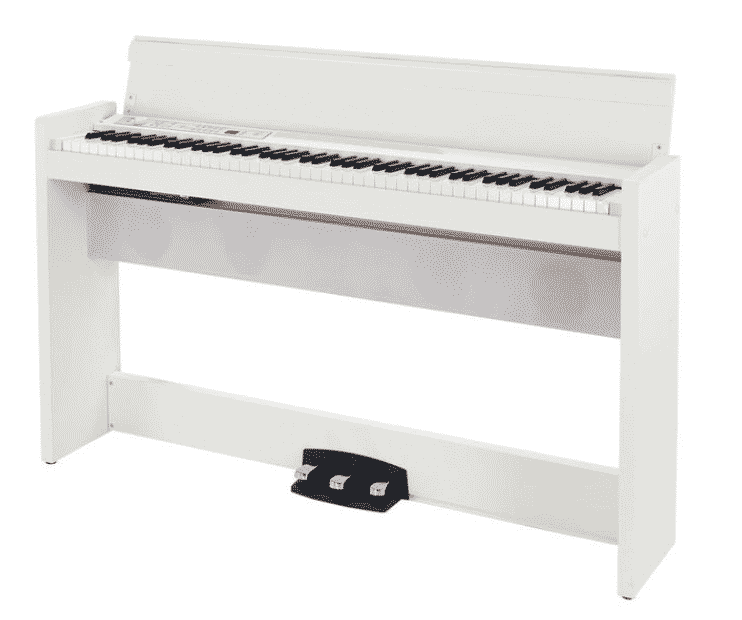
However, having said this, it’s not a bad action; I’ve certainly played worse. I’d put it on par with Yamaha’s GHS action, but it’s not as good as a modern Casio, Kawai or Roland action. If you’re a beginner or intermediate player, you shouldn’t have too much trouble graduating to an acoustic piano at some point if you bought the LP380.
Touch Sensitivity
The LP380 includes three levels of touch sensitivity; Light, Normal and Heavy. This is great for younger players, or those without much strength in their fingers, as it allows you to adjust the sensitivity of the keyboard and allow for a lighter touch. Conversely, if you find the normal touch sensitivity isn’t giving you enough expression, you can switch it to heavy, whereby you’ll have to press the keys very hard in order to get maximum volume.
This is a good feature for those learning the piano. However, one drawback is that I couldn’t find a way to turn the touch sensitivity off, which most manufacturers include. I wouldn’t make use of this feature, as I found the default touch sensitivity more than adequate. It’s good to know it’s there, however.
Keys
Not much to say here; Korg have included a set of plastic keys on the LP380, and haven’t gone with the “ebony and ivory” feel that so many manufacturers like to do nowadays. I appreciate this, as I’ve never understood why manufacturers do it. Piano keys aren’t made out of ivory any more and haven’t been for decades. If you look at the Yamaha U1, for example, the keys are made out of acrylic resin. In many ways, because of this, the keys on the Korg LP380 are more authentic than many pianos in a much higher price range.
Some manufacturers say that having plastic keys make it easier for your hands to slip off the keys, if you’re playing for several hours in a warm climate and your hands become sweaty, for example. However, I’ve never experienced this as an issue on a real piano and highly doubt this is anything for the intermediate player to worry about.
Included Accessories
You don’t get much with the Korg LP380, it has to be said. This is all that’s in the box:
You don’t even get a music book that features the included songs; this is something I’ve come to expect from other manufacturers, and it’s disappointing that Korg didn’t include it here.
Fortunately, you won’t really need to buy anything else, because this is an all-in-one package, and you don’t need to buy an extra music stand or pedal board. You’ll need a screwdriver to put the piano together; this isn’t included.
However, as with any digital piano, I’d really recommend a good pair of headphones. Read my recommendation for the top 5 headphones for a digital piano.
Final Verdict
Our Rating: 4/5
Conclusion
An adequate instrument for the beginner or intermediate player. I’m sure at the time it was released, this piano was a serious contender, but it’s becoming apparent that this model is pretty dated, and is in need of an upgrade.
However, given its price, it is good value for money. It is difficult to recommend over the Casio PX160 or the Yamaha YDPS54; I feel with those models you get more for your money. However, if personal preference draws you to the Korg, I’d encourage you to buy one. Try these pianos out first!
Would I buy the Korg LP380? No, I wouldn’t. Should you? Yes; if it meets your expectations and your requirements.
Check the availability and the current price of the Korg LP380:
UK/USA/Canada
UK and Europe

In terms of sound authenticity, compared to the FP30X how does the Korg LP380U compare?
Thanks for the detailed review. I am planning to buy korg LP380U.
As It contains many different types of Piano voices which are sampled from various acoustic pianos, I’m interested in knowing if it includes sampled voice of Steinways Piano ?
I believe the grand piano sound is sampled from Steinway & Jazz Paino sound is either from bosendorfer or Fiazoli.
Just want to confirm.